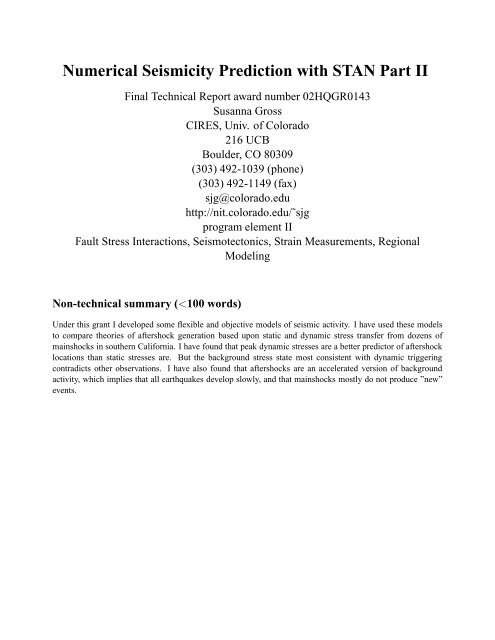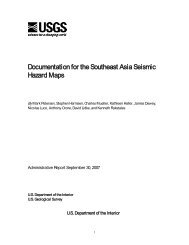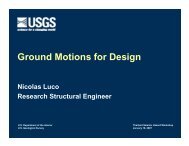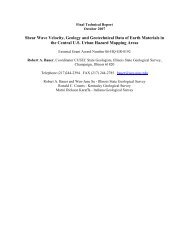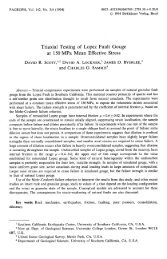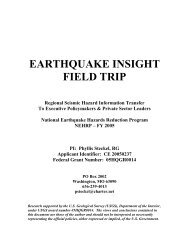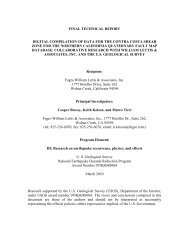download - Earthquake Hazards Program - USGS
download - Earthquake Hazards Program - USGS
download - Earthquake Hazards Program - USGS
Create successful ePaper yourself
Turn your PDF publications into a flip-book with our unique Google optimized e-Paper software.
Numerical Seismicity Prediction with STAN Part II<br />
Final Technical Report award number 02HQGR0143<br />
Susanna Gross<br />
CIRES, Univ. of Colorado<br />
216 UCB<br />
Boulder, CO 80309<br />
(303) 492-1039 (phone)<br />
(303) 492-1149 (fax)<br />
sjg@colorado.edu<br />
http://nit.colorado.edu/˜sjg<br />
program element II<br />
Fault Stress Interactions, Seismotectonics, Strain Measurements, Regional<br />
Modeling<br />
Non-technical summary (
Numerical Seismicity Prediction with STAN Part II<br />
award number 02HQGR0143<br />
Susanna Gross<br />
CIRES, Univ. of Colorado<br />
216 UCB<br />
Boulder, CO 80309<br />
(303) 492-1039 (phone)<br />
(303) 492-1149 (fax)<br />
sjg@colorado.edu<br />
http://nit.colorado.edu/˜sjg<br />
program element II<br />
Fault Stress Interactions, Seismotectonics, Strain Measurements, Regional<br />
Modeling<br />
Abstract<br />
Studies with the Stress Transfer and Nucleation (STAN) model have progressed considerably this year, with<br />
an improved optimization technique, better statistical measures of fit quality, and more accurate dynamic stress<br />
transfer calculations. The new fast approximate dynamic stress transfer model can be used to compute remarkably<br />
accurate static stresses, in spite of its approximate treatment of the free surface. Preliminary results suggest<br />
that peak dynamic stresses computed using this model are a better predictor of aftershock locations than static<br />
stresses are, especially beyond a few source radii. Both static and dynamic stress transfer models display considerable<br />
skill when compared to a fit using randomized stress steps. An expanded set of mainshocks has been<br />
studied using some new classes of aftershock decay model, leading to relatively modest improvements in fit<br />
that invite farther study. Currently, the best fitting model is a variation on modified Omori that includes a slight<br />
dependence of p-value upon stress step. There are also some indications that the response to stress steps is<br />
nonlinear, saturating when stresses exceed a threshold. The development of STAN has opened up many topics<br />
worthy of future research.
1 Investigations<br />
Stress Transfer and Nucleation<br />
STAN is a new kind of seismicity model which incorporates both spatial and temporal variations in<br />
activity, and quantifies how well we understand the earthquake nucleation process. STAN can be<br />
used to make formal seismicity rate forecasts, fit models of stress transfer triggering, and invert for<br />
tectonic loading patterns given observed seismicity. Although STAN is by no means fully developed,<br />
it has already been productive. In implementing STAN, I had to decide what seismicity response was<br />
expected when a volume is repeatedly stressed, and developed a new approach to that problem. STAN<br />
is constructed with a minimum of free parameters, and it allocates these parameters in proportion to<br />
the data, with a clustering algorithm which breaks apart three dimensional space in proportion to the<br />
seismic activity. Although STAN can be constructed with any underlying set of assumptions, the<br />
current version does not assume that seismicity is concentrated on mapped faults. It instead assumes<br />
that the long term spatial seismicity distribution will persist, and be modified by stress transfer from<br />
observed mainshocks. The stress transfer generates aftershocks in each volume in proportion to the<br />
stress step multiplied by the activity level of that volume. It is assumed that each volume produces<br />
background seismicity in proportion to that same intrinsic activity level multiplied by a loading rate.<br />
The loading rate can be assumed constant or varied with location. Similarly, STAN can be constructed<br />
with a great variety of assumed temporal aftershock decay models.<br />
A Procedural Outline of STAN<br />
1. Cluster events onto an adaptive grid.<br />
2. Compute stress transfer from mainshock sources to each subset.<br />
3. Apply aftershock generation and decay models to each stress subset to compute the ”activity”<br />
of that location given the observed event count.<br />
4. Evaluate statistical measure of fit for each subset.<br />
5. Optimize, adjusting generation and decay parameters to find best statistic.<br />
A key element of every STAN model is the battery of statistical tests used to evaluate the fit. Since<br />
STAN defines an expected seismicity rate as a function of time and space, it is well suited to evaluation<br />
with maximum likelihood techniques. Non-parametric Komolgorov-Smirnov (K-S) statistics are also<br />
used, because they provide better information about the quality of the fit than likelihood fits do. STAN<br />
models can also be evaluated by the quality of their forecasts. Ideally, we would wish that the models<br />
have predictive skill, and expect that the best models would make the most successful predictions.<br />
After some goodness of fit measure such as the K-S statistic has been optimized, so that the misfit
36˚<br />
35˚<br />
34˚<br />
33˚<br />
32˚<br />
240˚<br />
240˚<br />
25 km<br />
241˚<br />
241˚<br />
KS statistic, Dynamic stress fits<br />
242˚<br />
242˚<br />
0.00 0.15 0.30 0.45 0.60<br />
These statistics are combined into a single log likelihood statistic using their probabilities of<br />
Komolgorov-Smirnov statistics for a STANsignificance. subsets are shown, with the red representing poor fits.<br />
243˚<br />
243˚<br />
244˚<br />
244˚<br />
245˚<br />
36˚<br />
35˚<br />
34˚<br />
245˚<br />
33˚<br />
32˚
is minimized, the fit can be re-evaluated for true skill by comparing it with predictions based upon<br />
a much simpler algorithm, such as persistence. Tests such as these provide an objective basis for<br />
evaluating a huge variety of seismicity models, from exceedingly simple to absurdly complex.<br />
The adaptive grid is created very simply, and has 3 parameters that define it, the minimum and<br />
maximum grid size, and the minimum event count. It starts with a very fine grid covering the whole<br />
region of interest at a 1km resolution in three dimensions. Those cells that satisfy the minimum event<br />
count are kept, and the resolution of the grid is halved for all the others. Then the remaining events<br />
are compared with the new grid, and all cells meeting the minimum event count criteria are saved, and<br />
the resolution is halved again, until the maximum grid size is reached. Cells of the maximum size do<br />
not necessarily satisfy the minimum event count.<br />
2 Results<br />
There have been several new developments in STAN this year. There are new stress transfer models,<br />
more mainshocks, improvements to the fitting algorithm, and new statistical measures. New<br />
seismicity models are being developed. Space limitations prohibit a full discussion of all of these<br />
improvements, but the highlights are summarized below.<br />
A fast approximate stress transfer model was developed during 2002, under a combination of<br />
NSF and <strong>USGS</strong> funding. This dynamic stress transfer model was developed to compliment the static<br />
stress transfer models which have been a part of STAN from the beginning. It uses point sources<br />
and the method of images to compute stress histories inside the medium very quickly and without<br />
the numerical instabilities that plague most models of the seismic waveform. It includes the near and<br />
intermediate field terms that are so important for this application, and it runs about 280 times as fast<br />
as a reflectivity model. Complex mainshock sources are represented with hundreds of source points<br />
whose moment, mechanism and timing are constrained by a variety of seismic and geodetic observations<br />
(Wald and Heaton 1994, Wald Heaton and Hudnut 1996, Ji et al 2000). The most important<br />
limitations the fast approximate dynamic stress transfer model has are its inability to model structure,<br />
and the approximate free surface. The point source dynamic model satisfies the stress free condition<br />
in a way that does not produce surface waves, and so it would not be appropriate for observations<br />
beyond regional distances. The approximation was evaluated by comparing the static stresses from<br />
this model with exact solutions computed using the Okada (1992) equations, and found to be much<br />
more accurate than a reflectivity model, especially for stresses inside the medium, where triggering<br />
must be evaluated. The fast approximate dynamic stress transfer model was presented at the 2002 fall<br />
AGU meeting.<br />
This year the STAN inversion technique has been overhauled to make it more adaptive and robust.<br />
It is still a nested grid search, carried out in multi-dimensions, but the grid size now adjusts to the<br />
location of the best fitting parameters. If the current best fit lies at the edge of the grid, the grid is only<br />
moved, not reduced in size. This makes the algorithm somewhat similar to a downhill simplex, but
with a far greater number of field points. With downhill simplex, the global minimum is not always<br />
reached, because the objective function has fairly sparse sampling, and so it is often a good idea to rerun<br />
the optimization several times. STAN’s fitting algorithm is more reliable than downhill simplex,<br />
although it is still relatively slow and best suited to low dimensional inversions. After implementing<br />
the new algorithm, I no longer observe advantages of simpler models over more complex ones, except<br />
in predictive mode.<br />
log likelihood statistics of STAN fits<br />
Omori MOM Dieterich<br />
Static -3730 -3723 -4986<br />
Dynamic -3624 -3549 -5001<br />
Random -5615 -5424 -5311<br />
The table above is similar to the one that was presented at the EGS/AGU meeting in France during<br />
April 2003. It shows that the best models are the dynamic ones with the traditional modified Omori<br />
(MOM) temporal decay. Both static and dynamic stress transfer models show considerable skill when<br />
compared to a fit made with randomized stresses. If this model were ”just a fitting exercise” the<br />
randomized stresses would fit the observations as well as the static and dynamic stresses do. The log<br />
likelihood statistical measure pools the probabilities of the observed earthquake times being drawn<br />
from the theoretical distributions as evaluated for each STAN subset. This new approach to pooling<br />
the KS statistics which quantify the fits of the subsets is much more statistically correct than the<br />
previous weighted sum approach. The least negative log likelihoods fit the best. Although these fits<br />
correspond to very low probabilities, that is due to the large number (39640) of events being fit, and<br />
not an indication of a poor fit.<br />
Recently 49 mainshocks were added to the STAN models. Formerly, I included just 3 large mainshocks<br />
(1992 Landers, 1994 Northridge and 1999 Hector Mine), using detailed source models. These<br />
smaller mainshocks will necessarily be much simpler. Initially, I have represented them with simple<br />
point sources having an isotropically distributed stress step that decays with the cube of distance.<br />
Even this crude representation of smaller mainshocks improves the models, but not dramatically. I am<br />
planning to explore more accurate approximations to both the static and dynamic stresses for smaller<br />
mainshocks, and take into account their focal mechanisms.<br />
STAN is ideally suited for the study of aftershock decay models that depend upon both space and<br />
time, in an inseparable way. Currently the best fitting model is modified Omori, which is represented<br />
with a seismicity rate function Λ that can be separated,<br />
Λ(x, t) = X(x) × T(t)<br />
being simply a multiple of some function X that depends only on location, with a function T dependent<br />
only on time. Such separable functions can be studied without employing a model like STAN.
The temporal aspects can be ignored when one studies the spatial aspects, and vice versa. By contrast,<br />
the Dieterich seismicity theory isn’t separable. It involves stresses in its temporal decay, and is<br />
best studied with models that include both temporal and spatial aspects. Unfortunately the Dieterich<br />
models are not very well supported by the observations, as you can see in the table of statistics. But<br />
there is a whole universe of possible seismicity theories/aftershock models which have variations in<br />
decay with stress step and should be evaluated. Currently just a few of these possibilities have been<br />
explored. Motivated by some interesting variations in decay properties that can be seen in plots of<br />
the decay of subsets of the Landers aftershocks defined using stress step, I’ve introduced a variation<br />
on the modified Omori model, which includes a logarithmic dependence of p-value on stress step.<br />
Preliminary tests of this model have shown that it is a modest improvement over all previous models.<br />
Farther study is needed in order to determine if the improvement in fit is statistically significant.<br />
Another potentially significant question is just beginning to be studied with STAN is the potential<br />
nonlinearity of the seismicity response to stress. A few models in which the seismicity is predicted<br />
to saturate, producing the same amplification factor to all stress steps exceeding 20MPa have been<br />
constructed. These models provide slightly improved fits to the seismicity than the linear models<br />
do. I plan to investigate variations in the threshold and hopefully a variety of nonlinearities with the<br />
hope that they will help all of us decide on the physical mechanisms behind the seismicity triggering<br />
phenomenon.<br />
3 Non-technical summary (
5 Availability of data<br />
The research did not involve the collection of any new data, only the construction of models, so this<br />
topic does not apply. Colleagues interested in conducting research with these models should contact<br />
Susanna Gross at (303) 492-1039 or sjg@colorado.edu,<br />
Bibliography<br />
Gross, S. J., Failure Time Remapping in Compound Aftershock Sequences, accepted by Bull.<br />
Seism. Soc. Am., 93, to appear in August 2003.<br />
Gross, S. J., A model of tectonic stress state and rate using Northridge aftershocks, Bull. Seism.<br />
Soc. Am., 91, 263-275, 2001.<br />
Gross, S., STAN - The stress transfer and nucleation model, Fall AGU, San Francisco, CA, USA,<br />
invited talk, 2001.<br />
Gross, S. ,Implications of secondary aftershocks for failure processes, Fall AGU, San Francisco,<br />
CA, USA, contributed poster, 2001.<br />
Gross, S., Dynamic vs. static stress triggering models of aftershocks, Fall AGU, San Francisco,<br />
CA, USA, contributed poster, 2002.<br />
Gross, S., Tests of dynamic triggering with the Stress Transfer and Nucleation model, Spring<br />
EGS/AGU, Nice, France, contributed poster, 2003.


